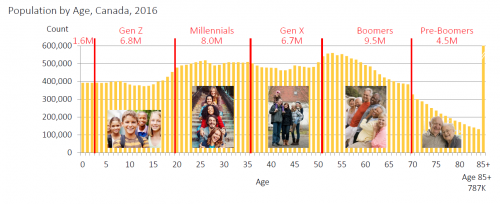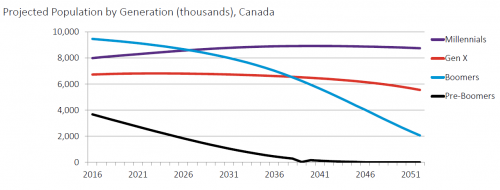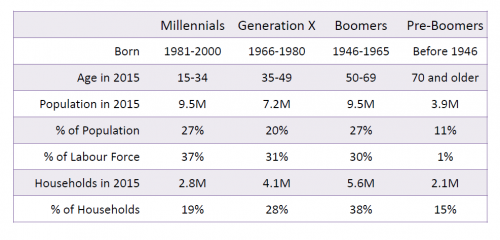

The young generation known as Millennials or Generation Y (That I the writer am a part of) have had many difficulties in pursuing careers and establishing them in the modern work world. In the past few decades many changes have occurred, and the days where you could begin working with an employer and stay with that same employer for decades and possibly even until retirement are long over. Job stability has become more volatile than it used to be. Many young people including degree and Ph.D holders are unable to find work in their related field and end up working in unrelated lower-paying jobs that often don’t use any of their education at all. This article will discuss struggles of Millennials trying to pursue GIS careers, how businesses contribute to the problem, and the benefits of hiring and training Millennials from a business perspective. It is a continuation to previously written articles about career challenges that young people in GIS face, strategies that schools can teach to help them succeed, and advice for those starting a GIS career.
Who Are the Geospatial Millennials?
The exact age range defining this generation varies from source to source, as do the statistics on them based on how the generation is defined, but for the purposes of this article we will use the definition given by Environics Analytics: people born between 1980 and 1995. Environics Analytics used 2011 Census data to project number of Millennials for 2016 and estimated the Canadian generation breakdown as follows:

Millennials are the currently the second largest generation after the Baby Boomers. They will grow from immigration and will eventually surpass the Boomer generation in numbers as Boomers become older and die. The Environics graph below predicts by about 2028 Millennials will be the most abundant generation in Canada, surpassing the Boomer population.

An earlier statistical breakdown published by Environics in 2015, widens the age range encompassing Millennials to include people born between 1981 and 2000, saying that in 2015 they comprised about 37% of the work force–more than each of the other generations. As the Boomers decline in numbers and retire and the Millennial population grows, this number will continue to climb.

Given the abundance and increasing prominence of Millennials in the workforce, it is important to note trends affecting them in the work force and the challenges they face.
The Problem with Millennials trying to pursue GIS careers
There are three general problems affecting Millennials trying to pursue GIS careers. First, there is little bridge between internship or summer student positions and entry level positions for those who are no longer students. Companies are happy to take on students while they’re in school, and getting early experience is certainly valuable and beneficial, but after graduation recent GIS grads have difficulty starting out or finding entry level work, especially because most entry level GIS positions don’t get advertised.
This first problem leads to the second problem: many companies often don’t want to take risks and prefer hiring an experienced and established person over an inexperienced young worker. This goes back to the chicken and egg struggle of many young professionals: you need experience to get a job, but you need a job to gain experience.
The third problem is many GIS positions, especially for less experienced individuals, are short term contracts or part time rather than permanent full time positions. Many modern business decisions are based on short-term thinking and hiring people for short term gains but without consideration for future growth.
The Consequences
The problems inherent in business decisions involving Millennials in GIS roles have several consequences. First, the difficulty in bridging the gap between school and post-graduation makes it difficult for recent GIS grads to find entry level positions and become established in their careers in the first few years after school. This is certainly not a problem specific to GIS and is a problem that Millennials face in all fields.
Second, replacing Millennials with Boomers or hiring Boomers instead of Millennials is counter-productive in the long term and closes the doors on younger people who are trying to become established in a GIS career. When the industry as a whole only invests in older, already experienced workers, it sets itself up to face a giant experience gap. Once Boomers retire or pass away, the industry will be left only with inexperienced workers that it failed to invest in.
Short-term hiring negatively affects Millennials’ ability to support themselves and their families. A person cannot live or plan for the future within this system, nor can they save for bigger purchases, make contributions to RRSP’s, or raise and support children when they are job hunting every six months. This in turn also negatively affects the economy as a whole due to younger individuals’ inability to contribute.
Also, giving younger people jobs with few hours, low wages, or lacking growth opportunities encourages them to leave a company for a better opportunity rather than stay with the same company long term, which perpetuates the short term hiring model.
From a business perspective, short-term hiring is inefficient as employers and supervisors must constantly hire and train new staff. It also causes employees to feel disposable and less valued to the company, which results in less job satisfaction and in turn damages productivity.
What Needs to be Done
There are many things which can be done to help resolve these problems. They include:
- Creating a bridge between student positions and entry level or under 5 year experience level positions for young GIS professionals no longer in school. Businesses need to help create these roles for young people.
- Investing in better training for young people to fill current and future gaps in an organization. There needs to be a continuing effort to move people forward in their careers by giving them growth opportunities in order to gradually fill the skilled positions the Boomers will leave behind in the next couple of decades.
- Replacing short-term and part-time positions with permanent full-time positions whenever possible–this is a win-win situation for both the organization and the employee. Businesses need to create opportunities to keep people and allow them to grow within that company to help make them invaluable assets to the company and help them establish their careers.
- Treating young professionals so they feel they are an asset to the company, that their work is meaningful, and that the company is providing them room to grow. This results in increased productivity and loyalty to a company.
Why Hire Millennials?

There are many advantages to hiring Millennials, and there is much value they can add to an organization. Hiring a Millennial is an investment in the future of a company and in the future of an entire generation of the work force. Having grown up with rapidly advancing technology, Millennials are adept at multitasking and learning new technology quickly, making them good candidates to learn new GIS-related skills, as well as applying technology to solving geospatial problems.
Young people add diversity to workplaces, and Millennials tend to be more open-minded and tolerant based on the changing social values and norms with which they grew up. Both diversity and these personality traits help create healthy workspace environments that are less likely to have cliques, discrimination, harassment issues and office politics (from “7 Benefits Of Hiring New Talent Over Experienced Pros”, FastCompany, 2014). Thanks to their familiarity with social media they are uniquely positioned to help companies to create new connections, networking opportunities, and potential future clients.
Helping Millennials Succeed
With recognizing the true value of Millennials as the next generation of workers worthy of investment; with recognizing their unique talents, abilities with technology and capacity to readily learn new skills and technology; with making more long-term decisions and be willing to take risks in hiring and training fresh Millennials in entry level GIS positions; and with training them with the goal of keeping them within a company long term and making them feel their work is valued, companies can help pave the way for this generation to succeed, continue to grow, and help fill future voids in jobs as Boomers leave the workforce and younger generations replace their roles.





Be the first to comment